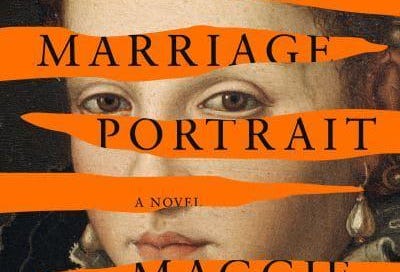Book Review: The Marriage Portrait
The Marriage Portrait by Maggie O’Farrell (Knopf, 2022).
“That’s why you should always read the last page first.”
This was my mom’s take when I told her that Maggie O’Farrell’s The Marriage Portrait had left me so unsettled I had trouble getting to sleep after finishing it. Without fully subscribing to that school of thought, I admit that there are times when I can see its appeal. I’ll try to discuss this book without spoilers, but the ending colored my feelings so much that it’s going to be hard.
Having been dazzled by O’Farrell’s previous novel, Hamnet, I snapped up The Marriage Portrait as fast as I could. And this one’s a dazzler too, in its own way. It’s based on the life of Lucrezia de’ Medici, the young wife of Alfonso II d’Este, Duke of Ferrara. Lucrezia died in 1561 at age 16, ostensibly of a fever, but it was rumored that her husband had poisoned her.
Lucrezia’s main claim to fame is being memorialized in one of Robert Browning’s best-known poems, “My Last Duchess.” In the poem, Duke proudly shows off to a visitor a painting of Lucrezia, while dropping hints that he had her killed. It’s a brilliant, eerie dramatic monologue, and it’s what inspired O’Farrell to write a novel about what might really have happened to Lucrezia.
The young duchess-to-be meets her future husband when he gets engaged to her older sister Maria. Only when Maria dies after a sudden illness is Lucrezia enlisted to become his bride. At first she finds the duke likeable, even kind and understanding. But how much of the kind-and-understanding act is genuine, and how much is superficial charm masking something darker? Lucrezia is not long left in doubt about this.
O’Farrell gives us her usual strong characterizations—of the sharp, restless young duchess and of the figures around her, maneuvering for power, status, and freedom. She paints an opulent but bleak world where loyalty and innocence are punished more often than they’re rewarded. And she masterfully intensifies the air of dread as Lucrezia begins to suspect that her husband, angered by their childlessness, plans to do away with her. The historical record strongly suggests that the infertility was the duke’s, not the duchess’s, and O’Farrell follows that record here. But if you know your history, you know that the men in these situations were not inclined to take the blame.
As the novel builds to its climax, O’Farrell begins to signal a possible deviation from the record, a way that Lucrezia might just defy history and our expectations and survive. Building an unexpected sense of hope into this grim story is an effective way to add to the suspense.
But when twist followed twist and led somewhere I didn’t foresee (though, in retrospect, there were several clues), both dread and hope were baffled, and I was left feeling startled and a little queasy. Again, I don’t want to give away too much, so I can only say that suddenly, the book seemed to undermine its own theme about the value and the rights of the most vulnerable.
I may be doing the author an injustice here; she may not have meant it quite the way I read it. And I’m not saying I didn’t like the book! I liked … well, about 95 percent of it. Let’s just say that, while it may not necessarily be an argument for reading the last page first, it definitely offers a lesson in being careful what you wish for.
(Cover image copyright Knopf.)
Book Links:
The Marriage Portrait on Amazon
The Marriage Portrait on Bookshop
Note: I forgot to mention that I learned about O’Farrell’s being inspired by Browning from an author essay in the Barnes & Noble Exclusive Edition of The Marriage Portrait. Here’s the link to that edition.



